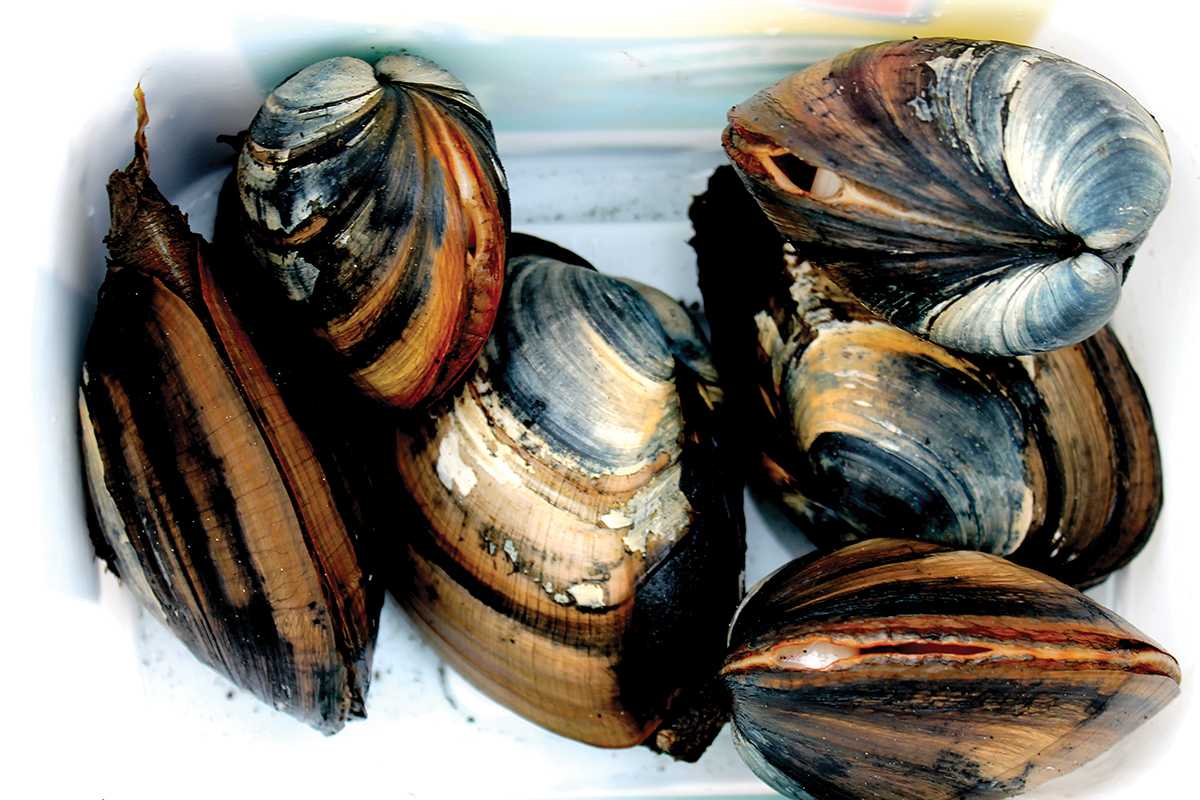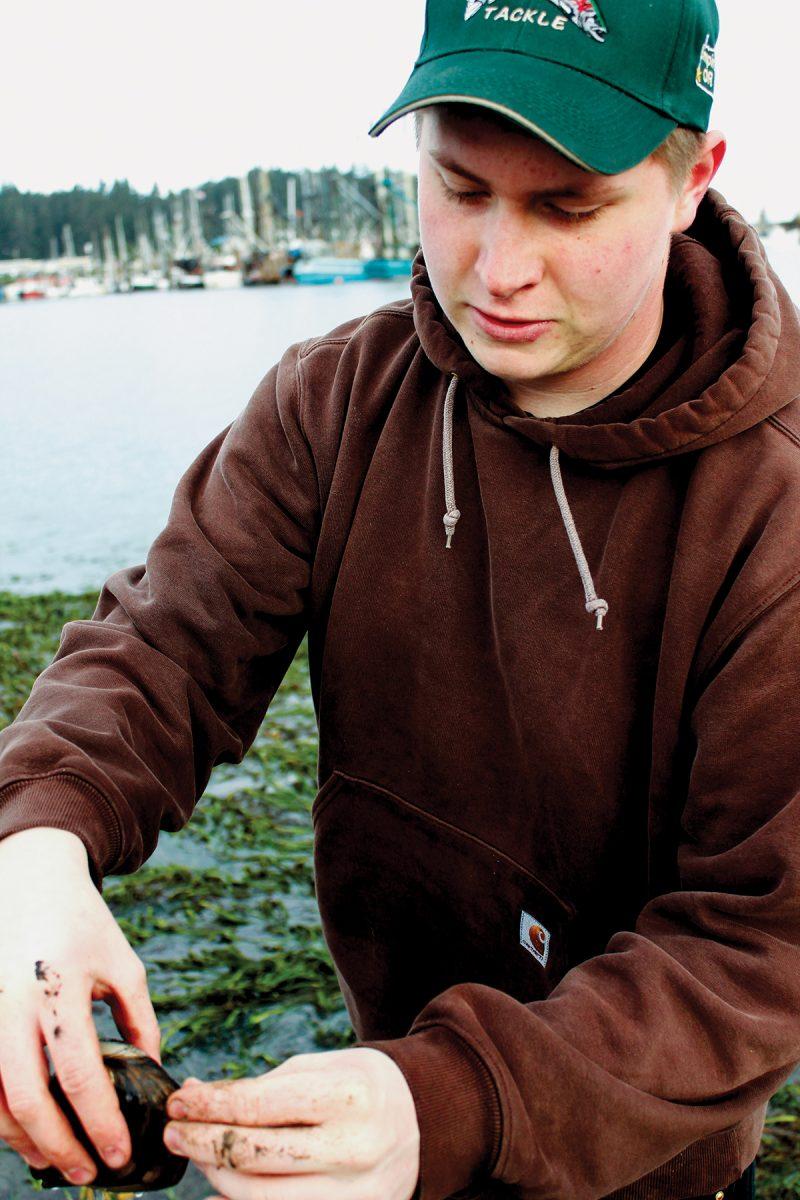Story by Felicia Kloewer
Design and photos by Rachel Monaghan
On a chilly Saturday morning Lyman Meade and his son, Lyman, are the only souls on the Charleston beach scouring the sand for dinner. Among clumps of glossy seaweed, broken clamshells, and molted crab exoskeletons, is a quarter-sized hole. Lyman Sr. sticks his index finger into the sand and probes the creature below. With a spade shovel he carefully digs into the dark sand, releasing the earthy scent of decomposition. Water shoots from the two-foot hole revealing their prize—an Empire clam.
Low tide in the early morning is the best time to find these impressive ten-inch clams perfect for hearty clam steaks and chowder. The estuaries near Charleston, Oregon, provide ideal habitat for bay clams like Empire, Martha Washington, and softshell. The Meades are at their favorite spot on the estuary across from the Charleston Marina & RV Park and the Fishermen’s Wharf. At 8 a.m. the dock is abandoned except for a lone sea lion barking in the distance.
Lyman Sr. grew up in Cottage Grove, Oregon, but moved onto the Coquille Indian Reservation in Coos Bay after marrying his wife, Brenda, a native Coquille. Members of the Coquille Indian Tribe have harvested clams for generations, and from them, Lyman Sr. learned how to recognize the signs indicating where a clam has burrowed beneath the sand. Lyman Sr. passed this knowledge onto his son, who then shares it with customers at Bites On Bait and Tackle, a bait shop where Lyman Jr. works.
On the beach, Lyman Jr. is harvesting another clam. He drives his shovel an inch or so away from a quarter-sized hole and heaves a mound of sand to the side. By digging next to the Empire’s hole, instead of on top, there is less risk of breaking the shell or accidentally cutting off the clam’s siphon, otherwise known as the “neck.” A broken shell won’t spoil the clam, but it makes cleaning more difficult, Lyman Jr. says. Water and dark gritty mud seep into the hole as he digs. Suddenly, a sandy neck protrudes from the hole. Lyman Jr. begins gently scraping mud away from the shell and plucks the mollusk from the ground before the mud can reclaim it.
The siphon consists of two valves that clams use to feed, breathe, reproduce, and move. Empires, commonly called gaper clams, got their name because their siphon is so large that the shells evolved to leave a gap for the siphon to protrude. Martha Washingtons also have a siphon, but it is tiny compared to an Empire’s and is easily hidden inside its shell. Located at the opposite end is the “foot,” a muscular appendage that allows the clam to burrow into the sand. The neck reaches up to the surface and uses one valve to bring water, oxygen and food into the shell. This is the sensation diggers feel when they stick their fingers in a clam hole.
As Lyman Jr. lifts the clam, water squirts from the crevice of its six-inch shell. “It’s not a big clam,” he says. “Some Empires can grow to between nine and ten inches across.” A good rule of thumb, Lyman Sr. adds, is the bigger the clam’s hole, the bigger the clam.
As the tide slowly advances up the beach, the Meades head inland toward a rocky patch of estuary where Martha Washingtons are found. The sharp crunch of empty clamshells echoes from beneath their boots and green sea anemones, exposed from the low tide, spray water as the men march across them.
Unlike Empire clams, Martha Washingtons create small oblong holes. This time, Lyman Sr. begins his dig right on top of the hole, noting that Martha Washington shells are less fragile. But instead of a clam, a long, red sandworm with scaly-looking limbs called parapodia wiggles across the sand. A digger may mistake a sandworm hole for a clam hole and unbury the critter.
With five to ten clams in each of their buckets, well below the maximum number of clams they are allowed to harvest in one day, the pair heads to the reservation to shuck their catch at the Coquille Community Plankhouse. Clammers may take up to 20 combined Empires and Martha Washingtons, but only 12 of the total catch may be Empire clams. Diggers over the age of 14 are required to carry their own license, shovel, and bucket. In Oregon the amount of each species that diggers are allowed to harvest is strictly regulated.
At the plankhouse, the Meades gather their equipment: a hose, a long wooden table, a few sharp knives and clamming knives—dull but flexible knives for prying meat away from a shell. The Meades first soak the clams in water and wait for the clams to open and reveal a sliver of flesh. To separate a clam from its shell, Lyman Sr. puts the flexible knife’s tip by the side of the neck and slices down between the shell and the fleshy body, repeating the process on the other side. The trick, he says, is to move quickly before the clam closes. If a clam snaps shut before it can be cleaned, it is placed back into the water, and the pair waits for it to open once again.
As the father and son finish shucking their clams, the plump bodies of gaper pea crabs emerge from the Empires’ flesh and litter the wooden table. These little crabs are found in Empire shells, but they pose no threat to the clam meat.
Before the clam meat is ready to be cooked into chowder or their necks tenderized into steaks, the clam’s flesh is thoroughly picked through. The Meades separate the neck from the fleshy body and store it in a water-filled container. This allows the necks to lengthen and loosen for bigger steaks. Then they clean waste from the clams’ stomachs and remove the slimy mucus-covered gills.
The stomach muscle, foot, and remaining bits are cleaned again and used for chowder. The neck can also be cut into chowder-sized pieces, but the Meades flatten these into delicious clam steaks. The necks are soft enough for Lyman Sr. to insert a sharp knife into one valve and cut through. He lays the exposed flesh on the table and cuts off the orange tip—a part that has been hardened and beautifully discolored by contact with the mud—from the clam’s white flesh.
With the clams clean, the cooking begins. Lyman Sr. takes a meat tenderizer and pounds the flesh until it’s thin as lace. It’s then covered in flour and garlic powder and tossed in a pan until browned on both sides. The remaining meat is chopped into bite-sized morsels ready for chowder. From their hour-long excursion on the beach, the Meades have shucked enough clams for a hearty bowl of chowder and at least a dozen clam steaks on the side.
The Dig for Dinner
Ethos
July 13, 2013
The Dig for Dinner
0
More to Discover










